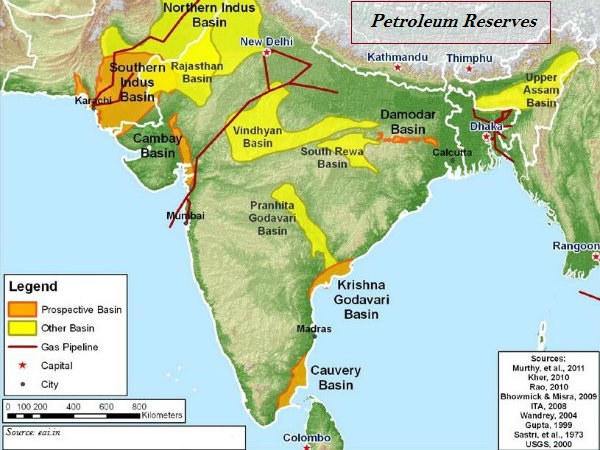
- Geography India - Introduction
- Geography India - Physical Aspect
- Geography India - Drainage System
- Geography India - Climate
- Geography India - Natural Vegetation
- Geography India - National Forest
- Geography India - Wildlife
- Geography India - Soil
- Geography India - Land Resources
- Geography India - Agriculture
- Geography India - Mineral Resources
- Geography India - Energy Resources
- Geography India - Industry
- Geography India - Transport
- Geography India - Communication
- Geography India - Foreign Trade
- Geography India - The People
- Geography India - Settlement
- Geography India - Migration
- Regional Development
- Geography India - Disasters
- Geography of the World
- Geography World - Introduction
- Evolution of the Earth
- Geography World - Climate
- Geography World - Transport
- Geography World - Communications
- Geography World - Population
- Human Settlement
- Human Development
- International Trade
- Geography Useful Resources
- Geography - Online Quiz
- Geography - Online Test
- Geography - Quick Guide
- Geography - Useful Resources
- Geography - Discussion
Geography India - Mineral Resources
Introduction
-
On the basis of chemical and physical properties, minerals are grouped as −
Metallic minerals and
Non-metallic minerals.
Major examples of metallic minerals are iron ore, copper, gold, etc.

Metallic minerals are further sub-divided as ferrous and non-ferrous metallic minerals.
The minerals containing iron is known as ferrous and without iron is known as non-ferrous (copper, bauxite, etc.).
Depending upon the origination, non-metallic minerals are either organic (such as fossil fuels also known as mineral fuels, which are derived from the buried animal and plant, e.g. such as coal and petroleum), or inorganic minerals, such as mica, limestone, graphite, etc.
Distribution of Minerals
Minerals are unevenly distributed on the earths surface.
All minerals are exhaustible in nature, i.e., will exhaust after a certain time.
However, these minerals take long time to form, but they cannot be replenished immediately at the time of need.
More than 97% of coal reserves occur in the valleys of Damodar, Sone, Mahanadi, and Godavari rivers.
Petroleum reserves in India are located in the sedimentary basins of Assam, Gujarat, and Mumbai High (i.e. off-shore region in the Arabian Sea shown in the map given below).

Some new petroleum reserves are also found in the Krishna-Godavari and Kaveri basins (shown in the image given above).
Mineral Belts in India
-
Further, there are three major mineral belts in India namely −
The North-Eastern Plateau Region,
The South-Western Plateau Region, and
The North-Western Region.
North-Eastern Plateau Region
The major areas of north-eastern plateau region are Chhotanagpur (Jharkhand), Odisha, West Bengal, and parts of Chhattisgarh.
Iron ore, coal, manganese, bauxite, and mica are the major minerals of the north-eastern plateau region.
South-Western Plateau Region
The south-western plateau region covers major parts of Karnataka, Goa, and contiguous Tamil Nadu uplands and Kerala.
Major mineral resources of south-western plateau region are iron ore, manganese, and limestone.
Kerala has deposits of monazite and thorium, and bauxite clay and Goa has deposits of iron ore.
North-Western Region
The north-western region covers the areas of Aravalli in Rajasthan and parts of Gujarat.
Major minerals of north-western regions are copper and zinc; other significant minerals include sandstone, granite, and marble, along with Gypsum and Fullers earth deposits.
In addition, Gujarat and Rajasthan, both have rich sources of salt.
The Himalayan belt is also an important mineral belt, as it has rich deposits of copper, lead, zinc, cobalt, and tungsten.
Major Minerals
Following are the major minerals found in india −
Iron
About 95% of total reserves of iron ore is found in the States of Odisha, Jharkhand, Chhattisgarh, Karnataka, Goa, Telangana, Andhra Pradesh, and Tamil Nadu.
Sundergarh, Mayurbhanj, and Jhar are the major iron ore regions in Odisha and the important mines are Gurumahisani, Sulaipet, Badampahar (Mayurbhaj), Kiruburu (Kendujhar), and Bonai (Sundergarh).
Noamundi (Poorbi Singhbhum) and Gua (Pashchimi Singhbhum) are important mines in Jharkhand.
Dalli and Rajhara in Durg district are the important mines of Chhattisgarh.
Sandur-Hospet area of Ballari district, Baba Budan hills, and Kudremukh in Chikkamagaluru district, and parts of Shivamogga are the important iron ore regions in Karnataka.
The districts of Chandrapur, Bhandara, and Ratnagiri are the iron regions in Maharashtra.
Other iron ore regions in India are Karimnagar and Warangal district of Telangana, Kurnool, Cuddapah, and Anantapur districts of Andhra Pradesh, and Salem and Nilgiris districts of Tamil Nadu.
Manganese
Odisha is the leading producer of Manganese.
Bonai, Kendujhar, Sundergarh, Gangpur, Koraput, Kalahandi, and Bolangir are the major manganese regions in Odisha.
Dharwar, Ballari, Belagavi, North Canara, Shivamogga, Chitradurg, Tumkur, and Chikkmagaluru are major manganese regions in Karnataka.
Nagpur, Bhandara, and Ratnagiri districts are the major regions of manganese in Maharashtra.
Balaghat-Chhindwara-Nimar-Mandla, and Jhabua districts are the important manganese regions of Madhya Pradesh.
Bauxite
Odisha is the largest producer of Bauxite in India.
Kalahandi, Sambalpur, Bolangir, and Koraput are the leading producers of bauxite in Odisha.
Lohardaga (Jharkhand) is rich in bauxite deposits.
Amarkantak plateau has rich deposits of bauxite in Chhattisgarh.
Katni-Jabalpur area and Balaghat are the major regions of bauxite in Madhya Pradesh.
Kolaba, Thane, Ratnagiri, Satara, Pune, and Kolhapur in Maharashtra are important bauxite producers.
Copper
Copper deposits are largely concentrated in Singhbhum district of Jharkhand, Balaghat district of Madhya Pradesh, and Jhunjhunu and Alwar districts of Rajasthan.
Mica
Hazaribagh plateau of Jharkhand and Nellore district of Andhra Pradesh have deposits of high grade mica.
Jaipur to Bhilwara and areas around Udaipur are the major mica-bearing regions of Rajasthan.
Other mica-bearing regions are Mysore and Hasan districts of Karnataka; Coimbatore, Tiruchirapalli, Madurai, and Kanniyakumari of Tamil Nadu; Alleppey of Kerala; Ratnagiri of Maharashtra; Purulia and Bankura of West Bengal.